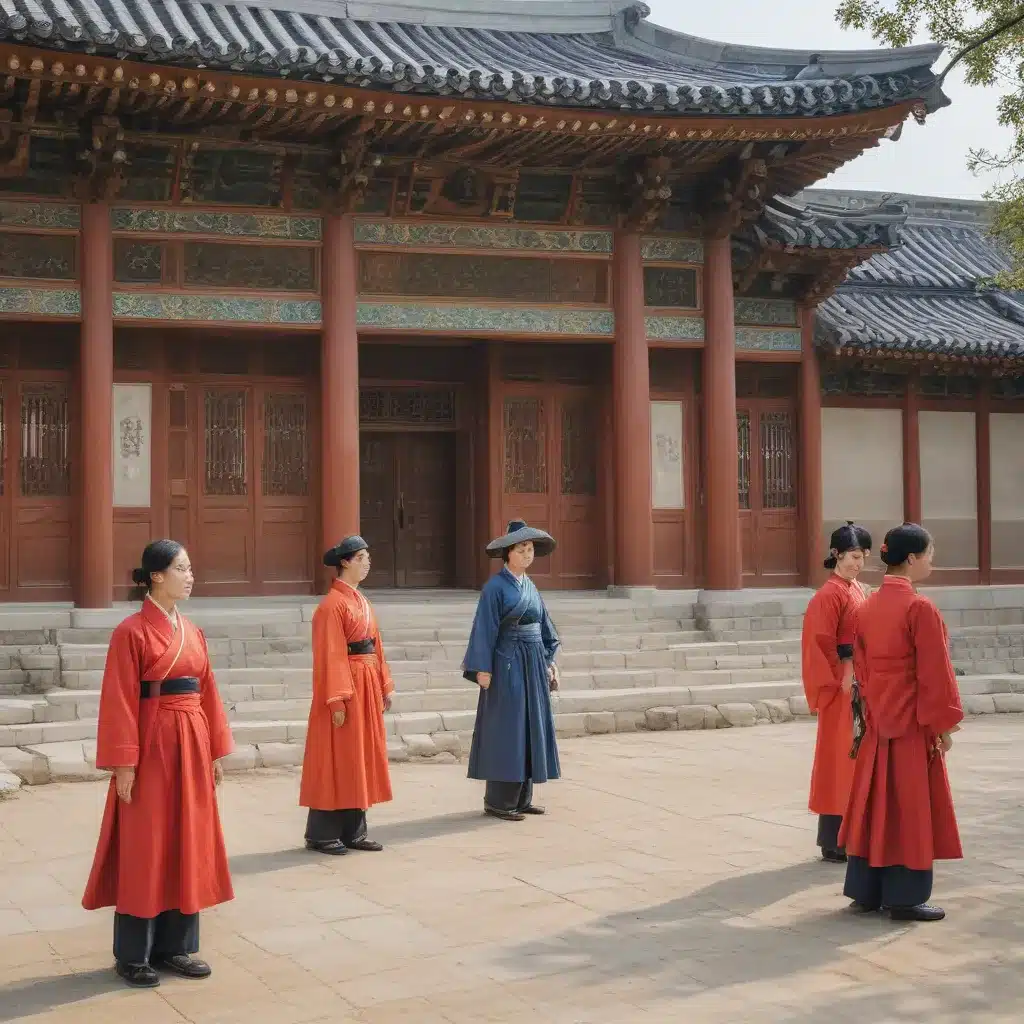
Uncovering the Majesty of Gyeongbokgung Palace
As I step through the towering gates of Gyeongbokgung Palace, I can’t help but feel a palpable sense of wonder and reverence wash over me. This grand 14th-century structure, once the seat of the Joseon dynasty, stands as a testament to Korea’s rich history and cultural legacy. The intricate architecture, with its graceful pagodas and ornate stone carvings, immediately transports me back in time, like a portal to a bygone era.
I find myself captivated by the meticulously manicured gardens, where ancient ginkgo and cherry blossom trees sway gently in the breeze. It’s easy to imagine the regal processions and lively court festivities that once filled these hallowed grounds. As I wander through the meticulously restored throne rooms and royal quarters, I can almost hear the echoes of the past, the whispers of the kings and queens who once walked these very floors.
The level of detail and craftsmanship on display is truly breathtaking. From the delicate woodwork to the vibrant murals adorning the walls, every inch of the palace seems to tell a story – a story of power, of tradition, and of the resilience of the Korean people. I find myself pausing at every turn, captivated by the intricate patterns and symbols that adorn the various structures, each one a puzzle piece in the grand tapestry of Korean history.
Unveiling the Secrets of the National Folk Museum
After my awe-inspiring journey through the grandeur of Gyeongbokgung, I decide to delve deeper into the cultural fabric of Seoul by visiting the National Folk Museum. As I cross the threshold, I’m immediately struck by the sense of cultural immersion that permeates the space. It’s as if I’ve been transported to a living, breathing time capsule, where the traditions and customs of the Korean people are on full display.
The museum’s vast collection of artifacts and exhibits is nothing short of impressive. From traditional hanok houses to intricate handicrafts and ritual objects, every aspect of Korean daily life is meticulously documented and preserved. I find myself drawn to the interactive displays, where I can learn about the significance of ancient ceremonies and festivals, or try my hand at traditional calligraphy and pottery-making.
One of the highlights of my visit is the outdoor folk village, where I’m able to wander through meticulously reconstructed traditional homes and workshops. Here, I can engage with costumed docents who bring the past to life, sharing stories and demonstrating the techniques that have been passed down through generations. It’s a truly immersive experience, one that allows me to connect with the rich cultural tapestry of Korea in a way that simply reading about it could never do.
As I explore the various exhibits, I’m struck by the sense of pride and reverence that the Korean people have for their heritage. Each display, each artifact, seems to be imbued with a deep respect for the traditions and values that have shaped this remarkable country. It’s a humbling and inspiring experience, one that has left an indelible mark on my understanding and appreciation of Korean culture.
Embracing the Past, Shaping the Future
As I reflect on my visits to both the National Palace and Folk Museums, I can’t help but feel a profound sense of gratitude and admiration for the Korean people and their unwavering commitment to preserving their cultural legacy. In a world that is often consumed by the relentless march of modernity, these institutions stand as beacons of tradition, reminding us of the timeless values and practices that have sustained communities for centuries.
It’s a remarkable feat, really, to so meticulously maintain and showcase the tangible and intangible heritage of a nation. From the intricate architecture and artwork to the interactive displays and live demonstrations, every aspect of these museums seems to breathe life into the past, inviting visitors to engage with it in a way that feels both educational and deeply personal.
But what strikes me most is the way in which these institutions are not simply relic-keepers, but rather dynamic hubs of cultural exploration and innovation. As I wander through the exhibits, I see how the lessons of the past are being woven into the fabric of the present, shaping the way that Koreans approach everything from design and technology to cuisine and the performing arts.
It’s a testament to the resilience and adaptability of the Korean people, who have weathered countless challenges and upheavals throughout their history, yet have managed to preserve the essence of their cultural identity. And as I prepare to depart, I can’t help but feel a renewed sense of inspiration and wonder – a desire to delve deeper into the rich tapestry of Korean history and culture, and to share what I’ve learned with others.
After all, isn’t that the true power of these museums – to not only preserve the past, but to inspire the future? To remind us all of the importance of honoring our heritage, while embracing the limitless potential of innovation and progress? As I step back out into the bustling streets of Seoul, I can’t wait to see what other wonders this remarkable city has in store.

